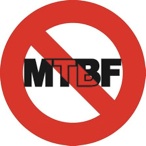 At first MTBF seems like a commonly used and useful measure of reliability. Trained as a statistician and understanding the use of the expected value that MTBF represented, I thought, ‘cool, this is useful’.
At first MTBF seems like a commonly used and useful measure of reliability. Trained as a statistician and understanding the use of the expected value that MTBF represented, I thought, ‘cool, this is useful’.
Then the discussions with engineers, technical sales folks and other professionals about reliability using MTBF started. And the awareness that not everyone, and at times it seems very few, truly understood MTBF and how to properly use the measure.
I found myself mentioning the full meaning and how I understood MTBF to others. This often turned into a short class or lecture. Maybe a quick turn to a technical reference or two to back up my claims. Then an assessment of the now common understanding of the measure and the topic which prompted the discussion.
Over time I’ve collected quite a few stories and events around the use and misuse of MTBF. I did a short presentation to a small audience of reliability professionals and received a lot of support and encouragement.
During one of these events the idea of creating a campaign button emerged. With the help of friends, a design and creation of the buttons happened. Over the past couple of years I’ve handed out nearly 1,000 buttons around the world. Of course you can have one, too
During another event I mentioned the eradication of MTBF was become a New Year’s Resolution, a Cause, or a Personal Mission. This was said in jest, yet there is some truth to the notion. Someone suggested that I set up a website around the topic and a quick search found the domain nomtbf.com was available. And, here it is.
As stated in many presentations, let me know your stories and ‘issues’ surrounding the use and misuse of MTBF. Lets learn from each other and continue the industries wide correction of the misunderstandings that remain.
Over next few months I plan to post articles, papers, presentations and hints & tips concerning the re-education of those that need it most – our peers, colleagues and coworkers.
Looking forward to more on this subject.
Answer this simple question to find how useless the MTBF measurement is, “What is the MTBF of a 30 year old man in the U.S.?”
Also the IEC seems to be using MTTF or Mean Time To Failure, is this worked out differently? see IEC 61850-3
Hi Paul,
Interest view of asking about age. MTBF is a failure rate and not age, and your question strikes at that mis perception directly.
IEC uses MTTF and it is calculated or estimated the same way – total hours divided by number of failures (or one if no failures). The IEC group and many others then debate endlessly about what is or is not included in ‘total hours’ and what is and is not a failure. Useless.
cheers,
Fred
Pehaps I’m alone in this perspective, perhaps not….
I and my staff generate and present MTBF data on many occasions. This typically stems from customer demand; given we have a number of customers who require MTBF data for our products. Whether it be publication or presentation of MTBF data, what I’ve seen ensue countless times (typically internally, but also from customers) is a debate – education on what is MTBF and “how can that be” the MTBF for “X”?! The discussion often evolves to frustration which then leads into a statisical class on accepting the MTBF calculation to spare all involved from going down the invitable dark statictical MTBF rabbit hole. I’ve reached the point where I’ve eliminated MTBF from various presentations to eliminate the confusion.
HI Ricci,
Excellent – you have found the same issues that I have and have taken action. Much of the call to eradicate MTBF is simply to avoid confusion. Use something useful and understandable instead, like reliability.
cheers,
Fred
Hi Fred,
I really appreciate your effort in providing insights on why MTBF should not be used as a requirement for reliability. The used of MTBF is really giving us problems in meeting customer requirements (by analysis and field demonstration). But the sad part is that all of our customers are still using MTBF as their requirement for reliability. One crazy example I can share with you is a requirement from a customer to meet MTBF of 19,500 hours for a complex subsystem by analysis (using MIL-HDBK-217) and field demonstration (in 6 months demo period using Chi-square with 90% CL and 10% consumer’s risk and 10% producer’s risk). If you were to talk to the customer, what would the best strategy to explain to them that their requirement is not appropriate.
Cheers,
Don
Hi Don,
I would ask them how many units they consider acceptable to have fail during mission time or some period of time (like five years). How much do they expect to have to pay for repairs and how long will down time be – and if that is acceptable or not.
When they point to MTBF or test data do the conversion to number of expected failures per year. That usually gets the discussion going.
good luck,
Fred
I am in CAPSIM as part of my MBA program. I find it totally ironic that professionals in the field do not subscribe to the MTBF theories, but professors and teachers preach it constantly, without debate nor backup problem solving.
And also that MTBF is not even broached until the last class, the most important class of the MBA program.
Hi Dianne, yes instead of MTBF, your professors should be talking about reliability and doing so earlier in the program. Without a relible product there is very little the MBA educaiton can do for you or your customers. cheers, Fred